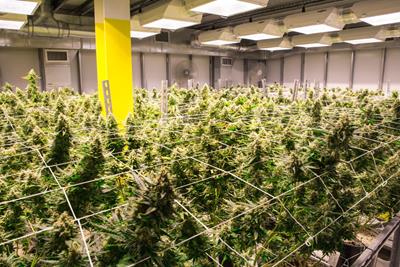
Sunday August 15, 2021
By Trevor Ross
 Growing
Growing
The Screen of Green (ScrOG) is a growing technique said to result in higher yields by maximizing light distribution. If you have a square light over a round plant, then inevitably the branches near the top will get more light than the ones at the bottom. Those branches at the bottom, then, are not photosynthesizing as much, and so producing fewer flowers.
The screen of green flattens out the plant so that all budding sites are on the same plane, and no light is wasted. It is often used by growers with a limited number of plants (such as under state ordinance), or by growers trying to optimize their grams to watts — the highest yield for the lowest energy output.
How to make a ScrOG
Any time you are binding or guiding plants with a fixed structure, try to use materials softer than the plant. String or garden twine is generally preferred. Wire works, but may be difficult to work with. Clipping and shaping wire can be a literal pain, and while you want the screen to guide your plants, metal will never yield to plant matter, and may break some stems. Taught string is sturdy enough--but still forgiving enough — to guide your plant as it grows.

Squares in the screen should be about 3 inches wide. String grids can be anchored to a metal frame, or threaded through eye hooks screwed into wood. However, you choose to rig the screen in your space, mount it as securely as you can. This could be as simple as zip-tying it to the frame in your grow tent, but some spaces will be more difficult. You may have to suspend it, or even build legs for it to stand over your plants.
Place the screen approx 24 inches above the cannabis seedlings.
Vegetative Stage
The process begins when the plant is in its infancy, so plan ahead and be ready. There are a couple of other growing techniques you’ll be practicing here, namely low-stress training, and topping.
Topping is a technique that consists of cutting the main stalk of the plant, which encourages the plant to divide its energy into two tops instead. Cutting your plant’s main stem may seem antithetical to healthy growth, but it’s a common technique also used on vegetables like peppers.
When your young plant has between three and five sets of leaves, cut the newest emerging growth. The latest remaining growths will then both grow like the “top” of the plant. Once that growth is established, this process can be repeated for four “main” colas, though most growers won’t push it much further. Too much repeated stress will tell the plant the environment is hostile, and instead of shaping further growth, you will only stunt it all together.
Next, you’ll be bending these branches while they’re still soft, using what is called “low-stress training.”
Low-stress training consists of bending — but not breaking! — the plant into a new, desired shape. An extreme example of this can be seen in some beautiful cannabis bonsai trees, but for a ScrOG, you’ll only be bending your highest colas down parallel to the ground. This can be done with gardening u-hooks, or simply with string.
Continue growing the plant as horizontally as you can until the flowering stage.
Flowering Stage
When to initiate the flowering stage comes down to dealer's choice. Some growers measure by how much of the screen is covered, waiting until 70% canopy cover to begin flowering; others initiate when the first budding site hits the screen. And still another may set a date on the calendar — after 14 days of tucking and threading--before they begin. If this is your first time, it is recommended you stick with whatever growing schedule you’ve used in the past to minimize new factors in your experiment. If this is your first time growing, then check out our guide and follow your heart.
Remember, though, the plant’s limbs will continue to grow for a couple more weeks into the flowering cycle. If you let them grow straight up, then you produce less of a “screen of green” and more of a scaffold for one winky plant. To produce a proper ScrOG, you’ll need to gently tuck these budding sites back down to continue encouraging the plant to grow horizontally.

Eventually, you will let them grow up through the nearest square in your screen, but if they’re all growing two feet over the screen, then what has all this been for?
Be gentle tucking the plants down one hole and threading them through others. This part of the process is laborious, but it’s also the name of the game. The effort will be worth it. This is where your plant is finally shaped through the screen. It’s all downhill from here, so don’t be in a rush to get this daily work over with.
Some growers opt to thread protruding branches back through the screen, weaving them up and down. Tucking is tidier, but whatever gets the plant growing horizontally should work.
Conclusion
From there, the growing process is largely the same as it would be without a screen, with temperatures between 65-85° F, a pH between 5.5 and 7, and the usual suspects of nutrients.
After splitting your main colas through “topping,” you may find that they are not as big as some other “main” colas you’ve grown, but what little weight you lose there should be more than made up for by the lower colas producing like tops. A good screen of green will grow evenly across the canopy, with no budding site prioritized by height or light.
What are your tips for making a ScrOG setup? Share them in the comments!







